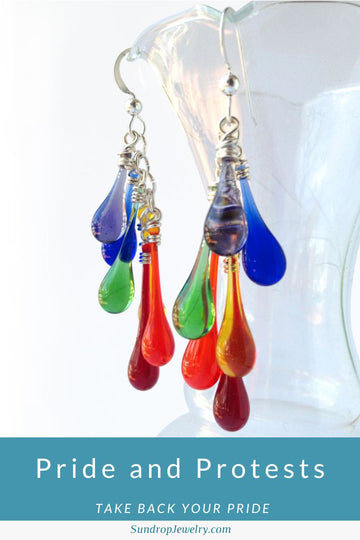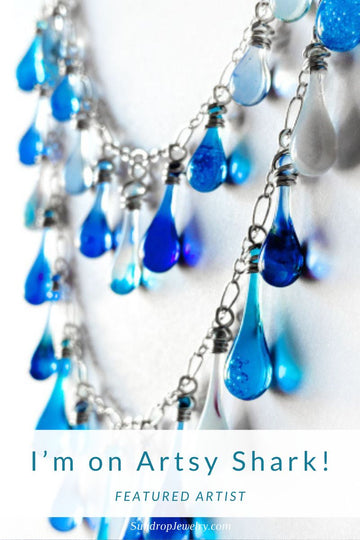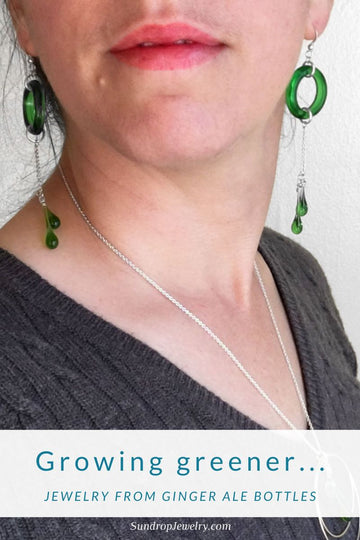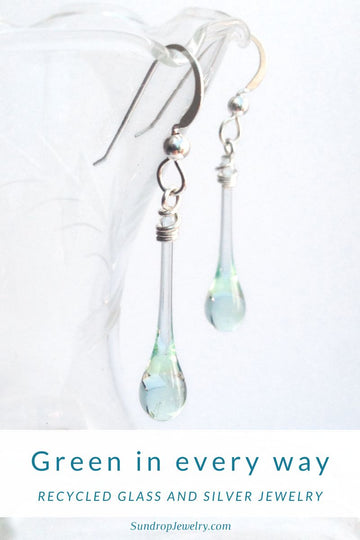News
Solar Energy Process - melting with a giant magnifying glass
by Erin McKittrick on Apr 22, 2007

Now for the fun part. Once we get all these materials to our studio (a.k.a. my house), what happens to them?

single-color sundrop The process is a bit different for single-color and multi-color sundrops. So I'll start with the plain ones.
First step: Cut glass into strips. Very little waste in this step.
Second step: Melt glass into drops using the giant magnifying lens.

Me working at the lens I melt glass with a giant fresnel lens. 41x31 inches, it's about 1270 square inches in area (0.82 square meters). Which means, at 1.4kW/square meter, about 1.1 kilowatts of energy are hitting the lens.
Melting glass with the Fresnel Lens
This is the fun part. First I tilt and aim the lens until the sunlight is focused on a rock attached to a wire stand. The lens rotates both horizontally and vertically, to adjust as the position and angle of the sun changes throughout the day. The rock moves up and down the wire stand for the same reason. With the rock as a backdrop, I can now see the bright spot where the sun is most intense (only with shade 8 welding goggles - it's bright!)Then I hold the end of the glass at the focal point (about the diameter of a fat pencil). The hot spot is pretty concentrated. As long as the piece of glass I'm holding is at least as long as a pencil, my hand is safe. And most of my body is actually in the shade of the lens.
The hot spot can get up to 3000 degrees Farenheit! But that depends on what I'm focusing on. Light has no inherent temperature - darker colored objects absorb more and will get hotter. Lighter colored things absorb less. Completely transparent glass - I can't melt at all.

glass heating in the lens The end of the glass strip starts melting within seconds. I continue heating it until I've got a good molten glob, then flip the strip over so the glob is pointing down. Gravity and surface tension pull the molten glass into a lobe that cools as it falls and stretches into the Sundrop shape.

sundrop dripping
Timing is critical here - if I screw up, it falls all the way to the ground, becoming flat on the bottom. The final sundrop is connected to the strip by a thin stringer of glass, which I break off to disconnect it.

putting the ball on the end Later, I take the sharp-ended sundrop, and hold it in a pair of tongs, remelting the end. Surface tension forms it into a ball - which I'll later use to hold the silver wire wrapping in place.
If you want to see this in action (and don't live in Seattle's University District), go to the Sundrop Jewelry web page and watch the movies!
Environmental Impact
Well, it's all solar, so I'm not using up any fuel. The main impacts from this step are a small amount of glass waste (sometimes I screw up the Sundrops), and the impact from producing the lens. I'm not sure what kind of plastic is in the lens or how hard it is to make, but since the lens will last for several years before it's too warped/scratched, I think it's not too big of a deal.
Comparison to Lampwork
Lampwork (making glass beads in a torch) is the most similar type of glasswork to what we're doing here. Since lampwork is often done on a small at-home scale, I couldn't find really good numbers on energy use. But beads can often take up to an hour to produce (an individual lampworked bead is usually larger and more detailed than a Sundrop). There are two commonly used kinds of torch setups - single fuel (propylene or propane), and dual fuel (propane + oxygen). For single fuel, a 1lb propylene tank lasts for 3-4 hours - so only a handful of beads. Dual fuel will be more efficient. And since lampwork beads are larger and need to be annealed, there's also energy used in a kiln heating step.
multi-color sundrop For single-color Sundrops, we have none of these fuel and energy costs - it's all solar.
For multi-color Sundrops, we do most of the heating in the lens - but there are some kiln and torch steps where we haven't managed to go solar yet - more on the impact of those next week.
Related Articles






Where did you get the lens from?
That’s such a great idea, your jewelry looks good too.